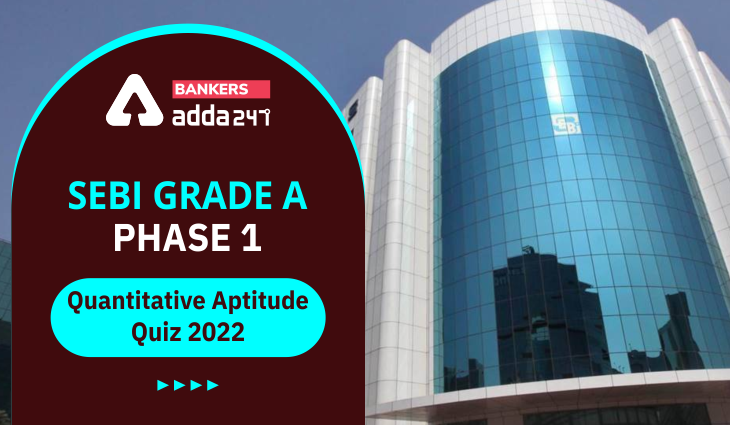Directions (1-5): The following questions are accompanied by two statements I and II. You have to determine which statements(s) is/are sufficient/necessary to answer the questions.
![]()
(a) Statement I alone is sufficient to answer the question, but statement II alone is not sufficient to answer the questions.
(b) Statement II alone is sufficient to answer the question, but statement I alone is not sufficient to answer the question.
(c) Both the statements taken together are necessary to answer the questions, but neither of the statements alone is sufficient to answer the question.
(d) Either statement I or statement II by itself is sufficient to answer the question.
(e) Statements I and II taken together are not sufficient to answer the question.
Q1. If a shopkeeper earns a profit of 24% by selling a shirt. Find the selling price of shirt.
I. He marked up the price of shirt Rs.150 above the its cost price.
II. Had he given discount of 20% on its marked price, he would have earned Rs.78 less than actual earning.
Q2. Find the speed of boat in still water.
I. Boat takes 9 hours to cover 77 km in upstream and then return the same distance.
II. If the speed of current is doubled, then time taken to cover 130 km, first in downstream, then in upstream is 18 hours.
Q3. Find the volume of right angle cone?
I. Curved surface area of cone 135π cm2 and total surface area of cone is 60% more than its curved surface area.
II. Volume of cylinder whose radius is 7/6th as that of cone and height is 25% more than the height of cone is 1653.75π cm3. Ratio of radius and height of cone is 3:2.
Q4. A, B and C started a business. Find the amount invested by A.
I. Respective ratio of profit share of A, B and C is 15: 16: 15 and B got Rs.8000 as his profit share.
II. Respective ratio of time period for which they invested is 5: 4: 3, and C invested Rs.10000 more than that by A and both of them gets equal share of profit.
Q5. In how many days P will complete the work, if Q takes 10 days more than P and R takes 4 days less than Q to do the same work.
I. Time taken by Q and R together is 10/9 days less than that by P alone.
II. P and R together will take less time than the time taken by Q and R together.
Directions (6-10): The following questions are accompanied by two statements I and II. You have to determine which statements(s) is/are sufficient/necessary to answer the questions.
(a) Statement I alone is sufficient to answer the question, but statement II alone is not sufficient to answer the questions.
(b) Statement II alone is sufficient to answer the question, but statement I alone is not sufficient to answer the question.
(c) Both the statements taken together are necessary to answer the questions, but neither of the statements alone is sufficient to answer the question.
(d) Either statement I or statement II by itself is sufficient to answer the question.
(e) Statements I and II taken together are not sufficient to answer the question.
Q6. Find the value of ‘qr – pq’ if r > q > p?
I. p, q and r are three consecutive odd numbers that are prime too.
II. p, q and r are in Arithmetic progression having common difference 2 and they are coprime to each other.
Q7. Piyush and Vikarsh started a business together. Ratio between profit share of Piyush to total profit is 3: 7. Find initial investment of Piyush?
I. Vikarsh invested 50% more than Piyush, while ratio between time for which Piyush and Vikarsh invested is 9: 8 respectively.
II. Piyush invested Rs.2,000 less than Vikarsh while Piyush and Vikarsh invested for 9 and 8 months respectively.
Q8. Find time taken by Amit to do a work is how much more/less than that of Chirag?
I. Amit is 100% more efficient than Chirag while Chirag and Amit together can complete that work in 20 days.
II. Birender who takes 30 days less than Chirag to complete a work is as efficient as Amit.
Q9. Sanjay told that, his son after x years will be one-fifth of his age, Sanjay’s wife Pooja told that their only son after x years will be one fourth of her age. What is sum of age of Sanjay and Pooja after x years.
I. The age difference between Sanjay and Pooja is 9 years.
II. Value of x is 3.
Q10. A group of people have to collect Rs.800 for a party and each one of them have to contribute equally. How many people were in the group.
I. Each one of them paid a multiple of 10 and number of people in group was also multiple of 10 and total number of people were less than money paid by each of them.
II. If 4 people left the group, then each one have to pay an additional Rs. 10
Directions (11-20): In the given questions, two quantities are given, one as ‘Quantity I’ and another as ‘Quantity II’. You have to determine relationship between two quantities and choose the appropriate option:
Q11. 5p men can complete a work in p/2 days while 2q men can complete same work in 4q/5 days.
Quantity I: Value of ‘q + 20’.
Quantity II: Value of ‘1.25p’
(a) Quantity I ≥ Quantity II
(b) Quantity I = Quantity II or No relation
(c) Quantity I > Quantity II
(d) Quantity I < Quantity II
(e) Quantity I ≤ Quantity II
Q12. Rs. P is invested in a scheme which offers 15% compound interest per annum. Interest earned after two years is Rs.3870.
Quantity I: ‘Value of ‘X’. Rs.2P is invested in a scheme which offers X% p.a. at C.I. and interest earned after two years is Rs.10560.
Quantity II: Value of ‘Y’. Rs. (P+6000) is invested for 2 years in a scheme which offers Y% p.a. at C.I. and amounts to Rs.28125
(a) Quantity I > Quantity II
(b) Quantity I = Quantity II or No relation
(c) Quantity I ≥ Quantity II
(d) Quantity I < Quantity II
(e) Quantity I ≤ Quantity II
Q13. Total surface area of a cylinder is 200% more than that of its sum of area of base and top of cylinder. Volume of cylinder is 2156 cm³
Quantity I: Volume of cone whose base radius and height is same as that of radius and height of cylinder respectively.
Quantity II: Volume of hemisphere whose radius is same as that of radius of cylinder.
(a) Quantity I > Quantity II
(b) Quantity I = Quantity II or No relation
(c) Quantity I ≥ Quantity II
(d) Quantity I < Quantity II
(e) Quantity I ≤ Quantity II
Q14. Average age of a group increased by 2 years if A who is 28 years old join the group. B, whose age is half the age of A, when joins the group, overall average age decreased by 1 year. ‘X’ is the initial number of people in group.
Quantity I: Value of ‘X’.
Quantity II: ‘3’
(a) Quantity I ≥ Quantity II
(b) Quantity I = Quantity II
(c) Quantity I > Quantity II
(d) Quantity I < Quantity II
(e) Quantity I ≤ Quantity II
Q15. When two ships P and Q are travelling in opposite direction crosses each other in 2 seconds and ship P is travelling in downstream and ship Q in upstream. Speed of ship Q in still water is 50% more than that of ship P. On a particular day, ship P was ahead of ship Q by 9 meters and both of them were travelling in downstream. If Ship Q overtook Ship P in 11 seconds. ‘X’ is the speed of ship P and length of ship Q is 54 meters.
Quantity I: 16 m/s
Quantity II: Value of ‘X’ in m/s
(a) Quantity I = Quantity II
(b) Quantity I ≥ Quantity II
(c) Quantity I ≤ Quantity II
(d) Quantity I > Quantity II
(e) Quantity I < Quantity II
Q16. There are ‘A’ numbers of cubes each having side 3 cm is melted and re-casted into a cylinder of radius 10.5 cm and height 12 cm.
Quantity I: Value of ‘A + 92’.
Quantity II: Value of ‘1.75A’
(a) Quantity I ≥ Quantity II
(b) Quantity I = Quantity II
(c) Quantity I ≤ Quantity II
(d) Quantity I < Quantity II
(e) Quantity I > Quantity II

Q18. Quantity I: value of P; A and B can complete a work in 36 and 45 days respectively. If they work together they complete 60% of the work in P days.
Quantity II: value of Q; A, B and C can complete a piece of work in 18, 30 and 54 days respectively. They all started working together but after 5 days, B left and remaining work completed by A and C. total work completed in Q days.
(a) Quantity I < Quantity II
(b) Quantity I ≤ Quantity II
(c) Quantity I > Quantity II
(d) Quantity I ≥ Quantity II
(e) Quantity I = Quantity II
Q19. Three friends P, Q and R started a business with initial investment of Rs.’x+3000’, Rs.’x’ and Rs.’x+6000’ respectively. After 6 months Q invested Rs.3000 more while P and R withdraws Rs.2000 and 3000 respectively.
Quantity I: profit share of P after 1 year.
Quantity II: average of profit share of Q and R after 1 year.
(a) Quantity I < Quantity II
(b) Quantity I ≤ Quantity II
(c) Quantity I > Quantity II
(d) Quantity I ≥ Quantity II
(e) Quantity I = Quantity II

Solutions




















 50+ Data Sufficiency Questions For Bank ...
50+ Data Sufficiency Questions For Bank ...
 Quantitative Aptitude Quiz For Bank Main...
Quantitative Aptitude Quiz For Bank Main...





